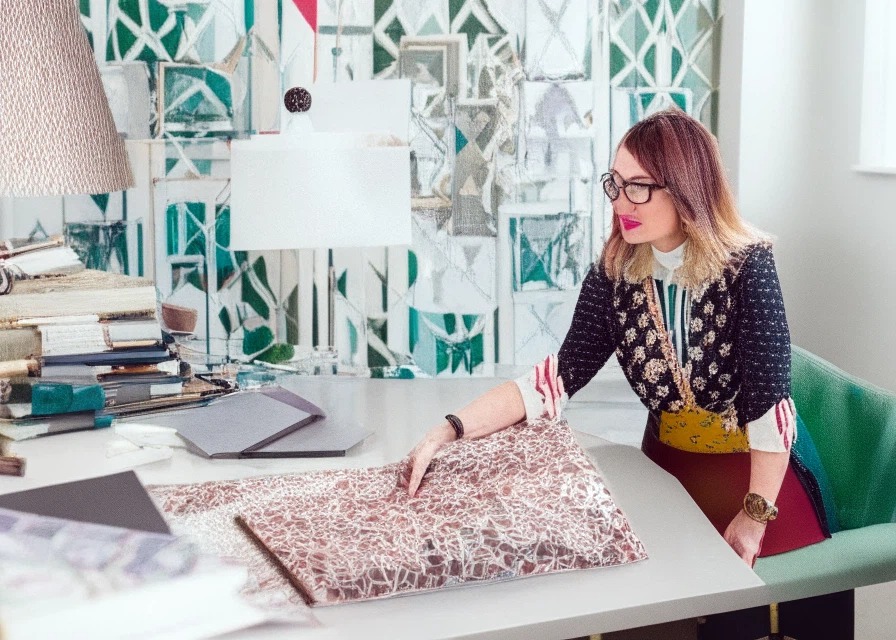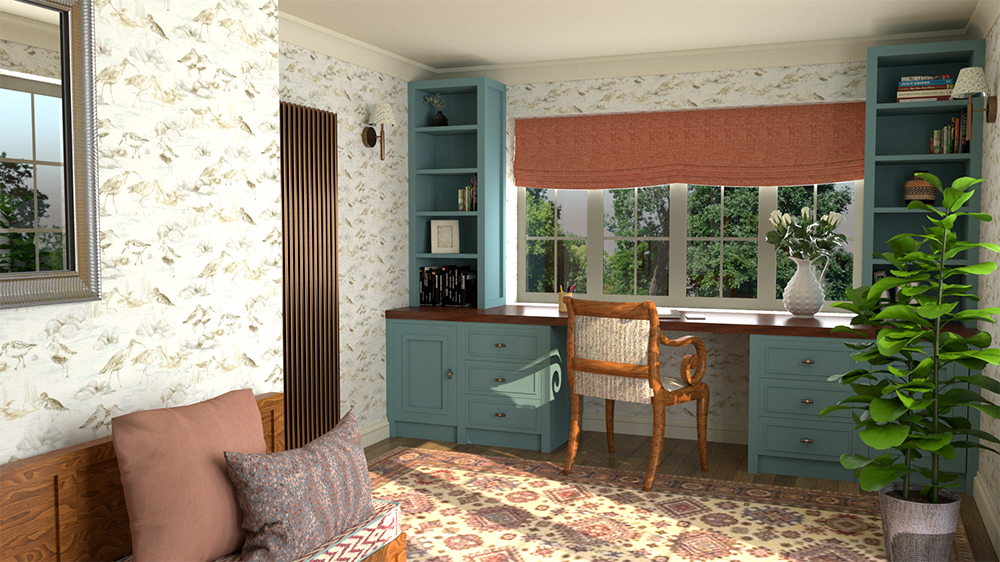Good Design Improves Lives

 |
||||||
| An AI generated image of an interior designer working at a desk, based on a photo of Louise | ||||||
|
One of my interior design colleagues in the States recently had a phone call with a potential client, and everything seemingly went well. A week went by without her hearing from the client, so she followed up to see if they still wanted help, and the client replied: |
||||||
| “We are trying the AI approach at first to see if it meets our needs” | ||||||
|
This is the first time this designer has had someone turn down her services in favour of using AI to design their home, and it’s the first time I’ve heard of this happening. As a community of designers, we have been talking about AI's potential significance for our profession for quite a while, but this is the first real evidence of its impact on our industry. So what does this mean? Can AI really replace the work of an interior designer? I thought I’d have a look at this as I’m sure it will come up with clients again. My initial thoughts were that most clients I’ve come across have trouble making decisions and narrowing down the many choices and options available to them, which is why they come to a designer - so will having more options and seeing more possibilities help them? For those of you who aren’t sure what AI is, it stands for artificial intelligence and whether we know it or not, we have all been using it for years. Anytime you’ve typed a message on your phone and it has finished the sentence for you, anytime you have used Google image search to find something which looks like a photo you have, or anytime you’ve had an interaction with one of those annoying chatbots when you visit a website, you’ve used AI. It can be really useful - it helps us navigate the roads with intelligent maps, you can use it to edit the photos on your phone to make sure everyone is smiling at the same time, and we even use it here to automatically explain our bank transactions in our accountancy software. It’s very powerful and will only get better and better. So how can it be used to help you design your home? |
||||||
| There are many apps and websites (both free and paid) that all say they will help you design your dream home, so with an open mind I thought I’d try them out and let you know my thoughts. Most of them work with the ‘prompt’ method, which means that you type in words or sentences to describe what you are looking for, and then they generate a few images showing you different versions of a room which resembles your prompt. For example, you might write that you want to see a living room in a maximalist style using a blue and red colour palette. You will then get a few images which have been generated by AI, usually by using photos of existing rooms and mixing them together with imagined elements to make the new room. | ||||||
|
I searched for a suitable AI image generator to try and found a free app called PromeAI and gave it a go. I typed the prompt ‘interior traditional kitchen with green cabinets and marble worktops’ and got three images in around a minute (the paid version will generate them more quickly). Here are the three images the AI tool came up with: |
||||||
|
||||||
|
As you can see, the images are all quite similar, with the same style of kitchen, the same shade of green used on all the cabinetry, and similar flooring. Overlooking the slight technical problems (cabinets with handles that don’t seem to be attached to them, cabinets with doors that don’t cover the whole cupboard, an extractor fan which doesn’t have any depth for the pipework), I wondered if these images are actually useful to someone trying to design their home? I personally found them quite uninspiring, as they were all so similar and didn't have many other colours or materials in them, and very little else of interest. But, if I was struggling to imagine what a green kitchen with marble worktops could look like, then these images could be useful. They could even be shown to a designer and used as a starting point for the design to develop, and I often work this way using Pinterest instead of AI with my clients. I use it to help kickstart the design conversation around the potential style of client’s homes, and it is extremely useful. Could AI be helpful to use in this way, as part of the design process? I decided to run the exact same prompt through Pinterest, to see what it came up with. I got a variety of different images which popped up in seconds - here are a few: |
||||||
|
||||||
|
The images from Pinterest were much more diverse - the styles and layouts of the kitchens were all different, and there were elements in lots of the images which I liked and could pick and choose from. Even though all the kitchens are traditional in style, they each have a different mood and feeling and would help me to narrow down what I was actually looking for. For example, do I want a dark green kitchen? How do I feel about tiles all the way up to the ceiling? These images sparked questions which would help me get closer to my dream kitchen. So far, Pinterest was proving more helpful than AI. But then I considered that perhaps my kitchen prompt to AI wasn’t the most inspiring, and that was causing the images it generated to be dull. I asked our admin assistant, Cerys, to come up with a different prompt for AI to use. She has been considering decorating her living room with a blue striped wallpaper and having yellow cabinets built into the alcoves, so she suggested I try that. Her prompt was ‘living room with blue and white striped wallpaper with yellow built-in cabinets in the alcoves’. Here are the images that AI generated: |
||||||
|
||||||
|
Again, there are technical details that the AI has struggled with, but we can overlook those. My main concern was that the images are all very similar to each other - the same shade of blue in the wallpaper, the same colour on the yellow cabinets, and they are essentially three versions of the same thing. Cerys looked at this and wasn’t inspired at all, in fact, she said it might put her off decorating her living room! So I ran the same prompt through Pinterest to compare the results. Here are a few of the images: |
||||||
|
||||||
|
She could see some elements she really liked - the paler blue wallpaper, the difference in the stripe widths which made her consider how wide the stripes would be in her room, and she also liked that the design styles are varied (Mid Century, traditional and Scandi influenced). She even liked the paler blue built-in cabinetry, which helped shape her vision for the room, as she is now considering blue cabinets instead of yellow. A much more satisfying exercise in terms of inspiration. |
||||||
| At least for the moment, Pinterest is a better resource for ideas, as it shows you options around your starting point. AI so far had just given me back exactly what I asked for, and nothing more. It showed me what a room like this could look like, but if I weren't a designer, I might struggle to relate this to the shape and layout of my own kitchen or living room. Even though a lot of the images on Pinterest these days are AI generated and don’t exist in real life, the algorithm showed me possibilities and opened up my thought process. | ||||||
|
I needed to try a different approach with my experiment if I was going to see how useful AI is for interior design. One challenge which crops up often when I work with couples is that one person will prefer a completely different design style from the other, and marrying those two styles is part of my role in shaping their homes. I need to be able to understand two opposing genres and merge them in a way which satisfies both halves of the couple and looks stylish and cohesive overall. I am working with a couple right now who prefer different styles, so I thought I’d run their preferences through AI to see if it could help. The prompt I input this time was ‘a large living room which mixes Mid Century and Rococco design styles’ and here is what I got: |
||||||
|
||||||
|
I thought these looked pretty good - they are warm, pleasing to the eye and look like a successful marriage of the two styles. On closer inspection, I could see that the first image was mostly made up of Rococco style furniture and lighting, with little of the Mid Century in it. The colour palette is typically Mid Century, but would that be enough to satisfy the one half of the couple who really wanted a Mid Century room? The second image definitely has more of a Mid Century feel, but much less Rococco, so it might suffer from the opposite problem. I also noticed that the furniture was a hybrid of Mid Century shapes with Rococco styling, something which I’ve never seen anywhere in real life (I’m not sure it even exists), so if we were relying on the furniture to mix the two styles, my couple might be disappointed. The third image is more successful at mixing, but again it uses furniture that doesn’t exist and there are a lot of Rococco inspired pieces used to create the overall design feel. I think that until AI can really understand the characteristics of a design style, and not just merge images of each style, it wouldn’t be useful to homeowners who are trying to keep both parties happy. So far, we’ve been looking at AI which can provide inspirational images, but it can also do much more than that. There are some apps which say they can create a room image from a floorplan, or from a photo of a real room, so I thought I’d try them out too. I used a photo of an existing home office from a real client of mine, and uploaded it to a tool called ReRoom AI. I chose creative mode, added the room type (home office) and could pick one of the 24 design styles. I chose ‘French Country Charm’ as that was the closest match to my client’s design style. I could also pick a lighting style (ambient), a colour theme (blue) and a texture preference (wood). Here’s the ‘before’ picture of the real home, and the first image it generated: |
||||||
|
||||||
|
The first image is an office with a desk and chair, and you could say that ‘French Country Charm’ has been added in the wood textures and overall rustic feel. There is no evidence of a blue theme (my client’s favourite colour), and the window into the conservatory had been turned into a mirror. What I couldn’t tell the app was that the client and I had discussed moving the desk in front of the window so she would have a nice view when working, as the ability to add a prompt is a paid option. The app asks if you are satisfied with the result and offers another try if you aren’t, so I ran it through again. This was the result: |
||||||
|
||||||
|
This time it’s worse, as it’s now a living room, a fireplace has been added where one couldn’t exist, and the short wall under the conservatory window has been turned into a wooden chest of drawers. The office chair has two legs with no back and there appears to be a large loaf of bread on the floor! Clearly, this technology isn’t perfect yet, but these glitches will eventually be ironed out. My main concern here is that the AI hasn’t been able to take a brief from the client and consider what she wanted this room to be and how it would work for her. There are no creative solutions which meet her needs, with much of what is being suggested impossible on a practical level. How would my client implement a design like this in her home? For comparison, here’s the real design I created for her, which not only addresses her needs, it adds creative solutions and style just for her: |
||||||
 |
||||||
| our design for our client's home office | ||||||
|
ReRoom AI also has the ability to take a floorplan of a room and generate an image based on it. I thought this could work really well, as I find most of my clients struggle to visualise a floorplan as a real room in 3D (this is why I create 3D models for them so they can see the rooms as they will look when built). I uploaded a floorplan of the home office I had designed for my client and added the same theme, lighting and colour as before, this time using ‘preserve details’ mode. Here is the new AI generated floorplan: |
||||||
 |
||||||
| The AI generated floorplan of the home office based on our floorplanfrom ReRoomAI | ||||||
|
I was a little disappointed with this as it has taken away some of the important furniture (such as the desk under the window) and has just given me a slightly better looking floorplan with some colour added. Again, I was worried that my poor results might be down to my lack of experience with AI, so I tried again, this time using the ‘creative mode’, and this is the result: |
||||||
 |
||||||
| The AI generated floorplan of the home office floorplan showing the lines as shelves from ReRoomAI | ||||||
|
ReRoom has taken the lines of the floorplan and turned them into shelving above a desk. It’s still a home office, but not a very helpful image, and if I were a client it would leave me completely stumped as to how to improve my home office. Even if you did manage to create an image which looks how you want it to, how would you know where to find the items in it? They don’t exist, and you would struggle to use AI to tell you how the sofa you see will feel to sit on, or what it is made of, and how it will stand up to your kids jumping on it for the next ten years. It’s clear that AI can’t yet redesign the layout of your home, or tell you which wall to knock down to create the perfect open plan space, but these things will come in time. My main issue with using it for interior design is that it cannot create an individual and personal response to the home, to the people who live in it, their needs, and their surroundings and lifestyle. We need human input to do that, and need humans to process the often confusing and contradictory information which is given to us as designers. AI certainly can’t understand the things that clients don’t say when we are taking a brief, and can’t spot the clues that clients give us without realising, and use them to create a cohesive design for us. Once the designs are completed, AI can’t hold your hand through the professional process of implementing those designs and guide you through to the end result. I think that AI is a useful tool like any number of things which help you on the design journey (such as magazines, Pinterest, films, travel, and the natural world), but at the moment it can only be as good as the human input it receives, and it relies on what humans do with the output. I decided to ask ChatGPT (a text based AI tool) what the difference between AI interior design and a human interior designer is, and here is the response: "AI interior design typically refers to the use of algorithms and software to assist in the design process. This involves generating design recommendations based on user preferences, analyzing spatial layouts, suggesting color schemes, and even creating virtual 3D models of proposed designs. On the other hand, a human interior designer relies on their creativity, experience, and understanding of design principles to conceptualize and execute interior spaces. They often work closely with clients to understand their needs, preferences, and budget constraints, and then develop personalized design solutions accordingly. Human designers also bring a unique sense of aesthetic judgment and emotional intelligence to the design process, which can be challenging for AI systems to replicate. While AI can streamline certain aspects of the design process and offer valuable insights, human interior designers often excel in areas such as empathy, intuition, and the ability to adapt creatively to diverse client needs and preferences. Additionally, human designers can provide a level of personalization and attention to detail that AI systems may struggle to achieve." |

Welcome to the design blog, where you'll see posts about anything from the projects we are working on, to the latest fabric and wallpaper collections, and all things interiors related. We love colour, pattern, architecture and old buildings, and we love to share our finds with you.
Happy reading!